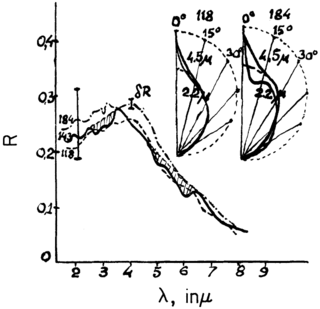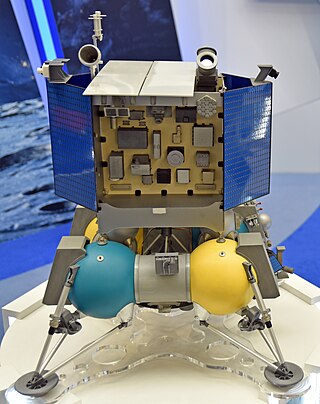Related Research Articles

Luna 16 was an uncrewed 1970 space mission, part of the Soviet Luna program. It was the first robotic probe to land on the Moon and return a sample of lunar soil to Earth. The 101 grams sample was returned from Mare Fecunditatis. It represented the first successful lunar sample return mission by the Soviet Union and was the third lunar sample return mission overall.

Luna 24 was a robotic probe of the Soviet Union's Luna programme. The 24th mission of the Luna series of spacecraft, the mission of the Luna 24 probe was the third Soviet mission to return lunar soil samples from the Moon. The probe landed in Mare Crisium. The mission returned 170.1 g (6.00 oz) of lunar samples to the Earth on 22 August 1976.

Lunar Prospector was the third mission selected by NASA for full development and construction as part of the Discovery Program. At a cost of $62.8 million, the 19-month mission was designed for a low polar orbit investigation of the Moon, including mapping of surface composition including lunar hydrogen deposits, measurements of magnetic and gravity fields, and study of lunar outgassing events. The mission ended July 31, 1999, when the orbiter was deliberately crashed into a crater near the lunar south pole, after the presence of hydrogen was successfully detected.

Lunar water is water that is present on the Moon. Diffuse water molecules in low concentrations can persist at the Moon's sunlit surface, as discovered by the SOFIA observatory in 2020. Gradually, water vapor is decomposed by sunlight, leaving hydrogen and oxygen lost to outer space. Scientists have found water ice in the cold, permanently shadowed craters at the Moon's poles. Water molecules are also present in the extremely thin lunar atmosphere.

In space exploration, in situ resource utilization (ISRU) is the practice of collection, processing, storing and use of materials found or manufactured on other astronomical objects that replace materials that would otherwise be brought from Earth.
The Solar System Exploration Research Virtual Institute (SSERVI), originally the NASA Lunar Science Institute, is an organization, established by NASA in 2008, that supplemented and extended existing NASA lunar science programs. Supported by the NASA Science Mission Directorate (SMD) and the Exploration Systems Mission Directorate (ESMD), SSERVI is a NASA program office located at the NASA Ames Research Center and was modeled on the NASA Astrobiology Institute (NAI) with dispersed teams across the nation working together to help lead the agency's research activities related to NASA's human exploration goals. Competitively selected team investigations focused on one or more aspects of lunar science investigations of the Moon, from the Moon, and on the Moon.

Chang'e 6 is a planned robotic Chinese lunar exploration mission that has been officially announced for the first half of 2024 and is expected to launch around May 2024. It will attempt China's second sample return mission. The mission will attempt to obtain the first-ever soil and rock samples from the lunar far side and return it to the Earth; the primary phase of the mission is expected to last about 53 days. Like its predecessors, the spacecraft is named after the Chinese moon goddess Chang'e.

Lunar Flashlight was a low-cost CubeSat lunar orbiter mission to explore, locate, and estimate size and composition of water ice deposits on the Moon for future exploitation by robots or humans.

Luna 27 is a planned lunar lander mission by the Roscosmos with collaboration by the European Space Agency (ESA) to send a lander to the South Pole–Aitken basin, an area on the far side of the Moon. Its objective will be to detect and characterise lunar polar volatiles. The mission is a continuation of the Luna-Glob programme.

Martian Moons eXploration (MMX) is a robotic space probe set for launch in 2026 to bring back the first samples from Mars' largest moon Phobos. Developed by the Japan Aerospace Exploration Agency (JAXA) and announced on 9 June 2015, MMX will land and collect samples from Phobos once or twice, along with conducting Deimos flyby observations and monitoring Mars's climate.

Resource Prospector is a cancelled mission concept by NASA of a rover that would have performed a survey expedition on a polar region of the Moon. The rover was to attempt to detect and map the location of volatiles such as hydrogen, oxygen and lunar water which could foster more affordable and sustainable human exploration to the Moon, Mars, and other Solar System bodies.

Commercial Lunar Payload Services (CLPS) is a NASA program to hire companies to send small robotic landers and rovers to the Moon's south polar region, mostly with the goals of scouting for lunar resources, testing in situ resource utilization (ISRU) concepts, and performing lunar science to support the Artemis lunar program. CLPS is intended to buy end-to-end payload services between Earth and the lunar surface using fixed-price contracts. The program was extended to add support for large payloads starting after 2025.

The Swamp Works is a lean-development, rapid innovation environment at NASA's Kennedy Space Center. It was founded in 2012, when four laboratories in the Surface Systems Office were merged into an enlarged facility with a modified philosophy for rapid technology development. Those laboratories are the Granular Mechanics and Regolith Operations Lab, the Electrostatics and Surface Physics Lab, the Applied Chemistry Lab, and the Life Support and Habitation Systems (LSHS) team. The first two of these are located inside the main Swamp Works building, while the other two use the facility although their primary work is located elsewhere. The team developed the Swamp Works operating philosophy from Kelly Johnson's Skunk Works, including the "14 Rules of Management", from the NASA development shops of Wernher von Braun, and from the innovation culture of Silicon Valley. The team prototypes space technologies rapidly to learn early in the process how to write better requirements, enabling them to build better products, rapidly, and at reduced cost. It was named the Swamp Works for similarity with the Skunk Works and the Phantom Works, but branded by the widespread marshes (swamps) on the Cape Canaveral and Merritt Island property of the Kennedy Space Center. The Swamp Works was co-founded by NASA engineers and scientists Jack Fox, Rob Mueller, and Philip Metzger. The logo, a robotic alligator, was designed by Rosie Mueller, a professional designer and the spouse of Rob Mueller.

The Intuitive Machines Nova-C, or simply Nova-C, is a class of lunar landers designed by Intuitive Machines to deliver small payloads to the surface of the Moon. Most locations on the lunar surface remain sunlit for approximately fourteen consecutive Earth days; Nova-C landers are expected to remain operational while in sunlight and are not designed to withstand the cold temperatures of a lunar night.

The Korea Pathfinder Lunar Orbiter (KPLO), officially Danuri, is South Korea's first lunar orbiter. The orbiter, its science payload and ground control infrastructure are technology demonstrators. The orbiter will also be tasked with surveying lunar resources such as water ice, uranium, helium-3, silicon, and aluminium, and produce a topographic map to help select future lunar landing sites.
The World Is Not Enough (WINE) is a US project developing a refuelable steam engine system for spacecraft propulsion. WINE developed a method of extracting volatiles from ice, ice-rich regolith, and hydrated soils and uses it as steam propulsion which allows the spacecraft to refuel multiple times and have an extraordinary long service lifetime. This would allow a single spacecraft to visit multiple asteroids, comets or several landing locations at an icy world such as the Moon, Mars, Pluto, Enceladus, Ganymede, Europa, etc.
The Lunar Polar Exploration Mission (LUPEX) is a planned joint lunar mission by the Indian Space Research Organisation (ISRO) and Japan Aerospace Exploration Agency (JAXA). The mission would send an uncrewed lunar lander and rover to explore the south pole region of the Moon no earlier than 2026.It is envisaged to explore the permanently shadowed regions on the Moon. JAXA is likely to provide the H3 launch vehicle and the rover, while ISRO would be providing the lander.

The Moon bears substantial natural resources which could be exploited in the future. Potential lunar resources may encompass processable materials such as volatiles and minerals, along with geologic structures such as lava tubes that, together, might enable lunar habitation. The use of resources on the Moon may provide a means of reducing the cost and risk of lunar exploration and beyond.

VIPER is a lunar rover developed by NASA, and currently planned to be delivered to the surface of the Moon in November 2024. The rover will be tasked with prospecting for lunar resources in permanently shadowed areas in the lunar south pole region, especially by mapping the distribution and concentration of water ice. The mission builds on a previous NASA rover concept called Resource Prospector, which was cancelled in 2018.
Jacqueline Quinn is an American engineer and inventor. She was one of the inventors of emulsified zerovalent iron, an environmentally safe material that can remove chlorinated solvent contaminants left from space exploration. She was inducted into the National Inventors Hall of Fame in 2018.
References
- ↑ "NASA - NSSDCA - Spacecraft - Details". nssdc.gsfc.nasa.gov. Retrieved 19 January 2023.
- ↑ Polar Resources Ice Mining Experiment-1
 This article incorporates text from this source, which is in the public domain .
This article incorporates text from this source, which is in the public domain . - ↑ Apollo to Artemis: Drilling on the Moon